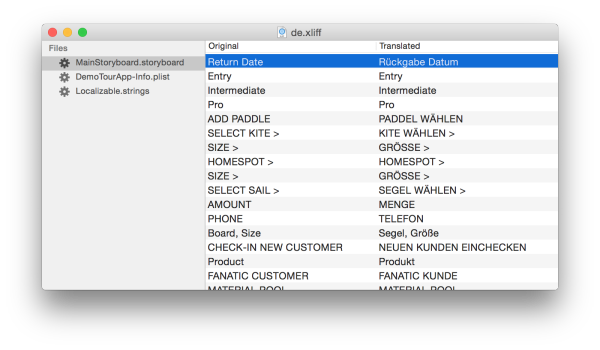Today we'll continue our localization series with a lesser-known Xcode feature that makes the process of translating our apps easier. Usually we won't be translating our apps ourselves, at least not into all the languages we want to support. It's common to send our strings off to a third-party service, who will translate them and return them to us.Let's get started. XLIFF is a well defined localization interchange format that bundles all localization strings in one file. Using XLIFF tools, the localization of Mac and iOS applications is straightforward. In this post, I want to present a (fairly) simple localization approach based on XLIFF. Mac App Store - iXLIFF. 120円; 悪く無いけど、Xliffieの方が作り込んである印象; XLIFF localization tools for Xcode 6 - Stack Overflow. StackOverflowで、アプリについてたくさん紹介されています。 上記2つがけっこう良かったため、特に他のアプリはチェックしていません。 参考. 我使用的工具 iXLIFF是我花了0.99€(译者:目前软妹币18)在App Store上买的。使用这个工具,翻译看起来如下: 使用这个工具,翻译看起来如下: 在这个例子中,我把一个应用程序从英语翻译到了德语。.
Today we'll continue our localization series with a lesser-known Xcode feature that makes the process of translating our apps easier. Usually we won't be translating our apps ourselves, at least not into all the languages we want to support.


It's common to send our strings off to a third-party service, who will translate them and return them to us. Let's get started.
In Bite #181, we enabled the basic localization features of Xcode. As we work on our app, we'll add new strings:
When we do, we could manually add the new key to all of the different language versions of our Localizable.strings file.
We could also generate a brand newLocalizable.strings file using Apple's genstrings command-line tool. Running gentrings *swift in our project's root directory will scan our code and generate a new Localizable.strings file with all the NSLocalizedStringkeys we've used.

That sounds like it could lead to lots of manual diff'ing.
It turns out that Xcode itself actually has a more powerful feature that can export our strings for translation with almost no manual labor. It pulls from all our Storyboards, .xibs, and scans our code for NSLocalizedStrings.
To use it, we'll select our project at the top of the Project Navigator, and then select Editor > Export for Localization... This will export a folder full of .xliff files for all the languages we've added to our project in Xcode.

This format is standard for most translation services. We'll find a service, then upload these files to them. They'll return us a similar set of files, filled with our translated strings. When they do we'll select Editor > Import Localizations... option then import them back into Xcode.
Ixali Ffxiv
Iliff Commons Ks
Popular translation services like Babble-on and Applingua specialize in mobile apps and support .xliff files. We could also edit the files ourselves using a tool like iXLIFF.




